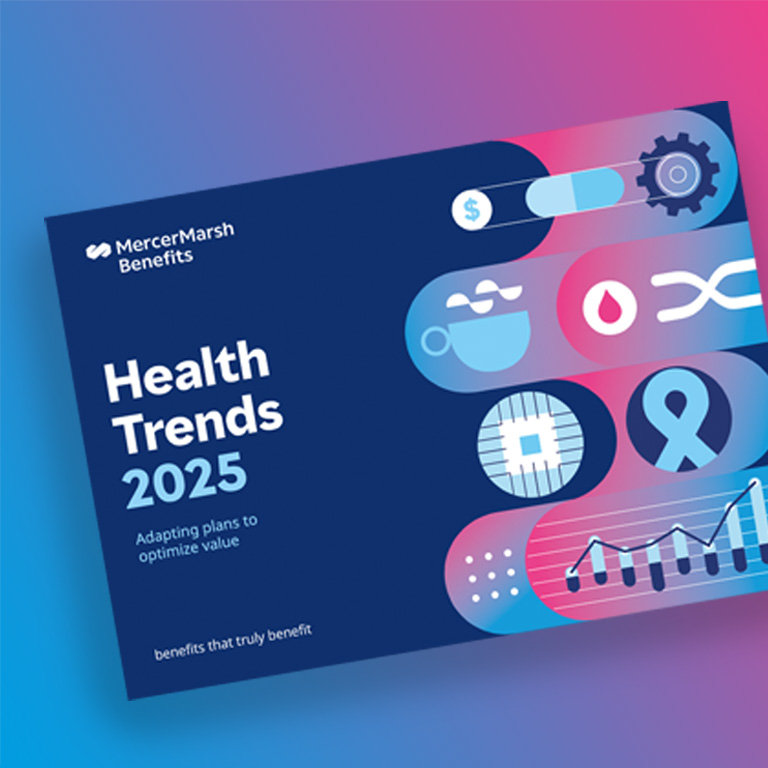
Stephanie Brunermer
Global Research and Solutions, MMB
-
United States
The COVID-19 pandemic has shown employers that the success of a business is dependent on the health and wellbeing of its workforce, with benefits programs gaining more attention from the C-suite. While this renewed emphasis is good news for employees, HR and benefits teams need to be laser-focused to ensure plans deliver the right value for money and support wider business objectives.
Nearly half (48%) of insurers report that public healthcare systems access has gotten worse since the pandemic. This could signal to employers that more employees will look to them to fill the gaps in healthcare systems around the world. Employers should be prepared for more complex financing and plan-design decisions. It’s important that businesses not only monitor these changes but also consider “pushing their insurers” to adopt more comprehensive and progressive approaches, such as steering individuals toward higher-quality care.
Closing these gaps may come with cost impacts and understanding claims cost drivers will be critical for containing costs over the long term. Our research indicates that medical cost increases are attributable not just to medical inflation but also to utilisation changes (for example, more claims) and changes in treatment mix (for example, advancements in healthcare technology.)
Despite these trends, insurers are reluctant to make changes to standard plan designs across their books of business. Employers need to take an active role in pushing insurers to consider addressing gaps created by government changes, and in doing so, also monitor plan experience, including high-cost claims, to limit the chances for surprises at budgeting time. By targeting a plan’s cost drivers, addressing gaps, and implementing policies to support prevention and condition management, employers can help mitigate claims risk over the long term.
By addressing gaps another area of focus for employers should be ensuring benefits are equitable. Inflation and the cost-of-living crisis have placed pressure on the cost of benefits programs for both employers and employees. Design elements, such as expense sub-limits and annual/lifetime maximums, can unintentionally shift costs onto employees, making care unaffordable. Employers should consistently review cost-sharing areas to ensure help is offered to employees who need it most.
Our People Risk 2022 research showed that administration and fiduciary risks have risen to the number-two spot out of 25 people risks globally, putting not just insured benefits but retirement, executive compensation and investment funds under greater scrutiny. As benefits increase in strategic importance and the C-suite becomes more involved in plan design, delivery and financing, we expect a greater need for benefits plan managers to create well-articulated multiyear benefits strategies linked to business objectives.
The first step for an employer is to focus on developing a clear governance model for its benefits plans. This includes developing a benefits philosophy, articulated through a list of guiding principles and objectives that help inform benefits design decisions. This work sets out the structure necessary to execute on plan changes needed in response to business initiatives, such as inclusivity; environmental, social and governance (ESG); or changing legislation.
Preparing for these benefits plan changes is key to success. Focusing on incremental changes each year creates space to allow for adjustment and feedback as needed to achieve goals. This helps stakeholders — including employees, unions, management, providers and investors — understand where you’re going and engage with the process.
Incremental changes also support cost containment, allowing the focus to be on improving value rather than slashing benefits. Going beyond just the next renewal cycle while planning for long-term changes can help benefits professionals balance economics with empathy.
Early engagement is the cornerstone of successful benefits plan redesign. As costs increase, budgets are likely to come under greater scrutiny. Ensuring senior stakeholders have a solid understanding of what you want to accomplish will help them to engage and get on board. They need to hear the same messages repeatedly and consistently, tying those messages to wider business objectives.
Consider establishing a benefits strategy steering committee to provide transparency and address any challenges. Ideally, this committee would be multidisciplinary, bringing together areas such as health and safety, risk management, and finance. Additionally, including broader functions, such as talent acquisition, ESG, and DEI, can bring a wider audience into the discussion. Make sure unions and works councils have an opportunity to engage on what’s important to employees. They need to understand and share information about any challenges to keeping plans sustainable.
Focusing on employee communications is crucial. Such communications should highlight that benefits are part of a mutual responsibility for advancing personal health. Our Global Talent Trends research shows that one in three employees would forgo a pay increase for additional wellbeing benefits. Creating a culture of health through benefits branding and influencer strategies can help your business and your employees.
Employers face a difficult environment, with competing needs pushing the boundaries of typical practice for benefits. Employers need to balance economics and empathy when reviewing plan design, keeping in mind the hardships many employees experience in the face of inflation. On the other hand, employers should acknowledge that many economies are not yet out of the woods when it comes to a possible recession.
Benefits professionals can remain focused by actively managing their plans, planning for the long-term changes needed and bringing all stakeholders into the process. These actions could be critical to your success.

Global Research and Solutions, MMB
United States

Global Benefits Management, MMB

Article
13/10/2024